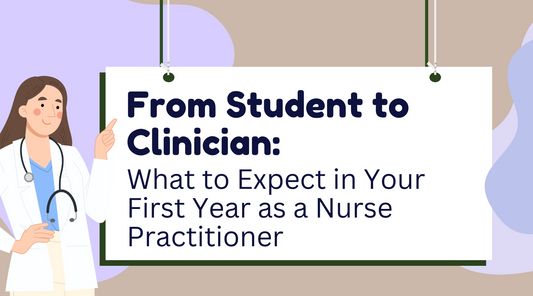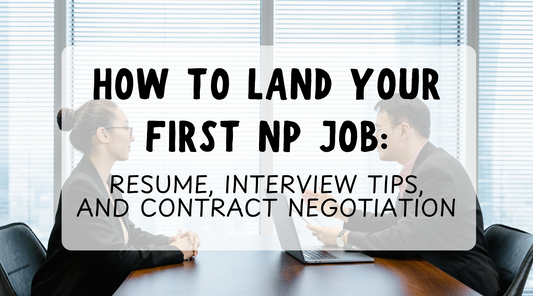Congratulations on Passing Your Boards—What Comes Next as a New Nurse Practitioner?
You did it! You successfully navigated through nurse practitioner (NP) school, passed your board exam, and are ready to embark on your career as a Nurse Practitioner! But now what? It might seem a bit overwhelming at first, but remember: you’ve already accomplished so much, so take a moment to celebrate and soak it all in.
That sense of accomplishment is something you earned through hard work and dedication. Now, with your boards behind you, there are just a few more steps to complete before you can officially practice as a Nurse Practitioner. Let’s break down the essential steps you need to take next, starting with the credentialing and licensure process.
Step 1: Apply for Licensure with Your State’s Board of Nursing (BON)
The first step in officially becoming an NP is applying for licensure through your state’s Board of Nursing (BON). The process will vary depending on the state, so your first task is to visit your state’s Board of Nursing website to review the application instructions.
Typical requirements will include:
- A fully completed application
- Proof of identity (e.g., US passport or birth certificate)
- Application fee (typically around $200-300)
- Fingerprints or a background check
- Passport-style photo
In general, expect the process to take anywhere from 8-12 weeks to complete.
Important for California Applicants:
If you’re planning to practice in California, you will also need to apply for a Furnishing License at this stage. This license is required for NPs who plan to "furnish" or prescribe medications. Be sure to incorporate that into your licensure application to avoid delays!
Step 2: Ensure Your RN License is Active and Current
Before you can practice as an NP, you need to make sure your Registered Nurse (RN) license is current and active in the state where you plan to work. If you are relocating to a new state, you may need to apply for a new RN license to be eligible for practice in that state. Always double-check this requirement to avoid delays in the next steps.
Step 3: Apply for Your DEA License
If your NP role involves prescribing controlled substances (Schedules II-V), you will need to obtain a DEA license. The current cost of the DEA registration is $888, which lasts for 3 years. If you already have a job lined up, check with your employer to see if they cover the cost.
To apply for your DEA license, follow these steps:
- Select "New Application".
- Choose DEA Form 224a for Mid-Level Practitioners (this is the most common form for NPs).
- Processing typically takes 4-6 weeks, so plan ahead!
To apply for your DEA license, you can begin the process here.
Also, check if your state requires any additional licensure to prescribe controlled substances here.
Step 4: Apply for Your National Provider Identifier (NPI)
Your National Provider Identifier (NPI) is an essential tool for practicing healthcare. This 10-digit number identifies you as a healthcare provider in national databases such as Medicare and Medicaid. Thankfully, getting an NPI is a straightforward process and it’s free.
Simply create an account with the Centers for Medicare and Medicaid Services (CMS) and fill out the NPI application. The process usually takes 10 days for approval.
Apply for your NPI here.
Step 5: Apply for Jobs
Technically, you can start applying for jobs during any of the previous steps, but keep in mind that employers will want you to have your credentials in order. It might take time for everything to come together, but the key is to remain proactive. Once you’ve secured your licensure, DEA license, and NPI number, you’ll be in great shape to start your job search!
Final Thoughts
Becoming a Nurse Practitioner is a journey, but now that you’ve passed your board exam, the end is in sight! While the credentialing and licensure steps may feel like hurdles, remember that they’re just the final few steps toward your exciting career.
Stay organized and persistent, and before you know it, you’ll be all set to begin working as an NP.
State-Specific Variations
This article is intended to guide new NP graduates in the U.S. Keep in mind, processes can vary from state to state, so be sure to check with your state’s specific licensing and credentialing authorities. Let me know if I’ve missed anything or if you have further tips to share—drop them in the comments below!
Good luck and congratulations again! Your future as an NP is bright! 🌟
Introducing the E-book: "New NP Guide: Step by step advice and support for the transition from RN to NP"

To support you on your journey, we have created an e-book, This resource is 70 easy to read pages that are designed specifically for new grad NPs and covers essential topics such as:
- AANP vs ANCC
- Exam Reviews/ Study Tips
- Step by step instructions for getting credentialed with links to DEA registration pages, NPI application page, and other resources
- Resume Tips (Includes free editable NP resume template and cover letter)
- Interview Prep
- Job Offer Checklist
- Job Offer Red Flags
- Negotiating tips
- Finding a mentor
- NP Fellowships
- Useful NP resources
- Tracking CE hours
- Tackling Impostor Syndrome
- Self Care
- Malpractice Insurance
This e-book is a valuable companion that offers practical advice and insights to help you thrive in your first NP job. Whether you're just starting your search or have already secured a position, this guide will support you every step of the way.
Transitioning from a new grad NP to your first job is an exciting phase filled with opportunities for growth and development. Embrace the challenges, build your confidence, and approach the job search process strategically. Remember, every experience is a chance to learn and improve. And to further aid you on your journey, don't forget to check out our e-book here: New NP Guide



